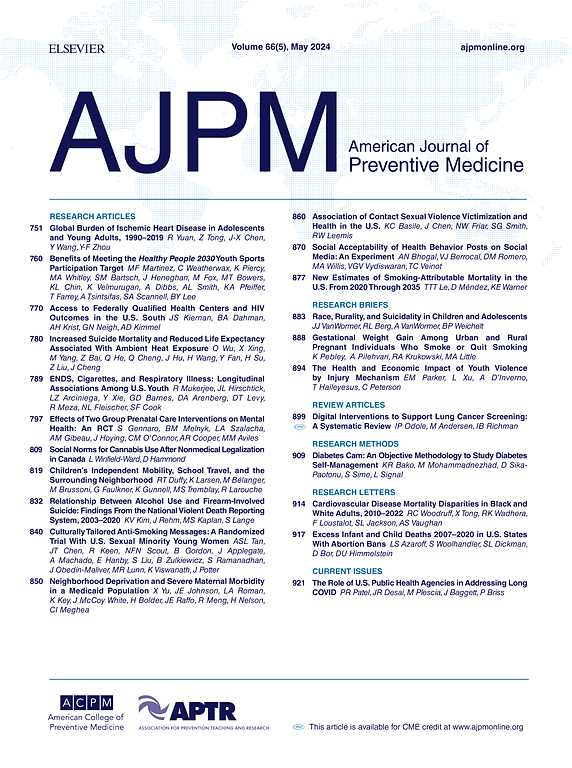防止弱势家庭儿童夏季体重增加的免费夏令营代金券项目的成本效益。
IF 4.5
2区 医学
Q1 MEDICINE, GENERAL & INTERNAL
引用次数: 0
摘要
简介:夏令营(SDC)可以通过提供一个促进健康行为的结构化日常环境来减轻夏季体重增加,但对于低收入家庭来说,SDC的成本往往过高。本研究评估了为弱势儿童提供免费SDC以防止夏季体重增加的成本效益。方法:从南卡罗来纳州的一个低收入学区招募422名儿童,随机分配接受8-10周的免费SDC或在2021-2023年像往常一样体验夏季。增量成本-效果比(ICER)通过SDC成本除以干预组和对照组从夏初到夏末身体质量指数z分数(zBMI)变化的差异来计算。还计算了参与SDC的不同剂量下的ICERs。使用基于试验的zBMI结果的非参数自助方法进行敏感性分析,并与全国各地的SDC成本相匹配。成本效益的可能性是根据政策制定者可能愿意支持的一系列潜在成本来评估的。结果:与对照组相比,SDC代金券项目以1307美元的成本避免了0.0917个zBMI的增加,每减少0.1个zBMI,每个儿童的成本为1463美元。每周5天参加SDC,最高剂量,产生最高的成本效益。敏感性分析显示,自我引导的ICERs平均每避免0.1 zBMI花费2187美元,其中80%的ICERs每避免0.1 zBMI花费不到3500美元。结论:代金券计划可能具有成本效益,如果政策制定者愿意为每减少0.1 zBMI支付3,500美元,则成本效益的可能性为80%。本文章由计算机程序翻译,如有差异,请以英文原文为准。
The Cost Effectiveness of a Free Summer Day Camp Voucher Program to Prevent Summer Weight Gain Among Children From Disadvantaged Households
Introduction
Summer day camps can mitigate summer weight gain by providing a structured daily environment that promotes healthy behaviors, but summer day camps are often cost prohibitive to families with low income. This study evaluated the cost effectiveness of providing free summer day camps to disadvantaged children to prevent summer weight gain.
Methods
A total of 422 children from a low-income school district in South Carolina were recruited and randomly assigned to receive 8–10 weeks of free summer day camps or to experience summer as usual in 2021–2023. The incremental cost-effectiveness ratio was calculated by dividing summer day camp cost by the difference between the intervention and control groups in changes in BMI z-scores from the start to end of summer. Incremental cost-effectiveness ratios at varied doses of summer day camp participation were also calculated. Sensitivity analyses were conducted using nonparametric bootstrapping of trial-based BMI z-score outcomes, matched with summer day camp costs from across the country. The probability of cost effectiveness was assessed over a range of potential costs at which policymakers may be willing to support.
Results
The summer day camp voucher program averted 0.0917 BMI z-score gain relative to the controls at a cost of $1,307, yielding an incremental cost-effectiveness ratio of $1,463 per 0.1 BMI z-score averted per child. Attending summer day camp 5 days per week, representing the highest dose, yielded the highest cost effectiveness. Sensitivity analyses showed that the bootstrapped incremental cost-effectiveness ratios averaged $2,187 per 0.1 BMI z-score averted, with 80% being <$3,500 per 0.1 BMI z-score averted.
Conclusions
The voucher program is likely cost effective, with 80% probability of cost effectiveness if policymakers are willing to pay $3,500 per 0.1 BMI z-score averted.
求助全文
通过发布文献求助,成功后即可免费获取论文全文。
去求助
来源期刊

American Journal of Preventive Medicine
医学-公共卫生、环境卫生与职业卫生
CiteScore
8.60
自引率
1.80%
发文量
395
审稿时长
32 days
期刊介绍:
The American Journal of Preventive Medicine is the official journal of the American College of Preventive Medicine and the Association for Prevention Teaching and Research. It publishes articles in the areas of prevention research, teaching, practice and policy. Original research is published on interventions aimed at the prevention of chronic and acute disease and the promotion of individual and community health.
Of particular emphasis are papers that address the primary and secondary prevention of important clinical, behavioral and public health issues such as injury and violence, infectious disease, women''s health, smoking, sedentary behaviors and physical activity, nutrition, diabetes, obesity, and substance use disorders. Papers also address educational initiatives aimed at improving the ability of health professionals to provide effective clinical prevention and public health services. Papers on health services research pertinent to prevention and public health are also published. The journal also publishes official policy statements from the two co-sponsoring organizations, review articles, media reviews, and editorials. Finally, the journal periodically publishes supplements and special theme issues devoted to areas of current interest to the prevention community.
 求助内容:
求助内容: 应助结果提醒方式:
应助结果提醒方式:


